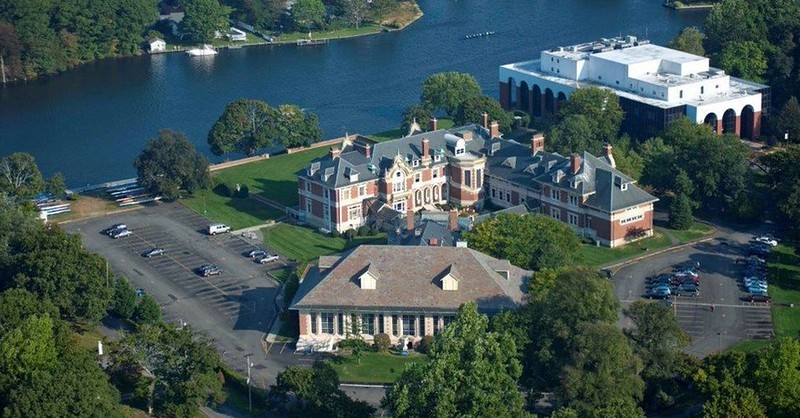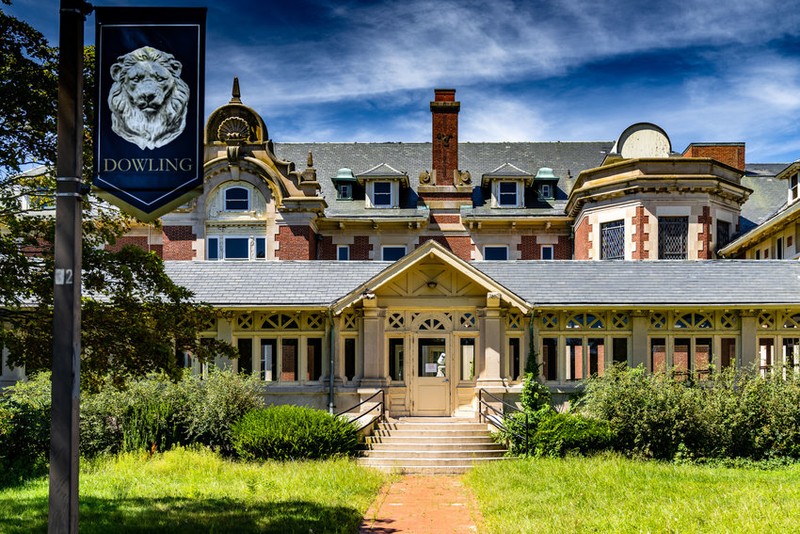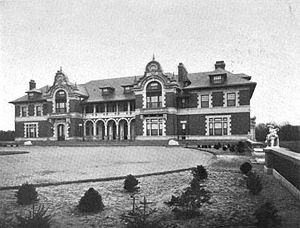Idle Hour (Vanderbilt mansion, formerly Dowling College)
Introduction
Text-to-speech Audio
Images
Aerial view of Idle Hour

Part of the mansion when it housed Dowling College

The home as it appeared in approximately 1903

Backstory and Context
Text-to-speech Audio
In 1876, William Kissam Vanderbilt, grandson of Commodore Cornelius Vanderbilt, purchased 900 acres along the Great South Bay and along the east side of the Connetquot River. He built a country house that he named Idle Hour, as well as a hunting lodge, on the property in 1879. The original Idle Hour was designed by famed architect R.M. Hunt, but was destroyed in a fire in 1899.Construction of new estate began almost immediately. The new home, also named Idle Hour, was designed by Richard Howland Hunt, son of R. M. Hunt.
The newly-constructed Idle Hour was built on an grander scale than its predecessor. The focal point of the estate was the Baroque-style main house, which consists of 110 rooms. It was built with masonry and fire-proof terra cotta to prevent another fire. In addition to the main residence, the estate also included a coach house, a tea house, a bowling alley, an ice house, an engineer's cottage, and workmen's housing. The estate also featured a clock tower, with a jeweler coming from a nearby town once a week to wind it and other clocks on the estate. A million and a half bricks went into the construction of the clock tower and the surrounding farm area. Most of the buildings constructed by the Vanderbilts are still standing and are now private residences. At its peak, the estate even featured a steamer to ferry the Vanderbilts and their guests up and down the Connetquot River.
After Vanderbilt's death in 1920, the estate was gradually broken up and now constitutes the Idle Hour section of Oakdale. In 1926, the area around the Clock Tower was purchased by Lucy Sawyer Pritchard Thompson and her son, William, who began to use that part of the estate as an artists' colony. The colony featured an exhibition hall, a theater, and classrooms for art, theater, and dance. The 1930s were the colony's heyday, but some of the artists who were invited there by Lucy Thompson continued to live in the Idle Hour Colony for decades.
But the artists only used part of the former estate. Other parts of the estate fell into various hands over the years, some of them far less respectable than the original owners. The gangster Dutch Schultz was said to use part of the estate as a hideout in the 1930s. At one point, an organization called the Royal Fraternity of Master Metaphysicians used the property as a "peace haven." Among the residents was reportedly a young woman that the organization claimed to have given immortality. At another point in its history, the National Dairy Institute used the mansion as a laboratory. They had their own unusual resident, reportedly--a cow with a window in its side so that the scientists could observe milk being made.
In 1962, the property was acquired by Dowling College, which used the mansion as its main building. A fire in 1974 seriously damaged the mansion (which Vanderbilt had built to be "unburnable" after the destruction of his first residence). Many of the building's most unique features were lost in the fire, and the building underwent a lengthy restoration before it could once again be used by the college. The college continued to operate at Idle Hour until 2016, when it shut down. The property has been vacant since 2017, and with no regular security, has been broken into and vandalized on several occasions. As of this writing, neither the mansion nor any of the other buildings on the estate are on either the national or state historic registers. Efforts are underway to have them named local landmarks so that they can be protected and preserved and will not be vulnerable to demolition.
Sources
Local History , Connetquot Public Library . Accessed April 24th 2021. https://www.connetquotlibrary.org/services/local-history/memory-lane/entry31.php.\
Idle Hour, Town of Islip, Suffolk County , Preservation Long Island . Accessed April 24th 2021. https://preservationlongisland.org/idle-hour-town-of-islip-suffolk-county/.
Harrison , Helen . Glimpses of an Almost Forgotten Artists Colony on L.I. , New York Times . February 6th 1983. Accessed April 24th 2021. https://www.nytimes.com/1983/02/06/nyregion/glimpses-of-an-almost-forgotten-artistscolony-on-li.html?searchResultPosition=10.
Jahn, Mike . A Troubled Landmark Reborn , New York Times . November 20th 1977. Accessed April 24th 2021. https://www.nytimes.com/1977/11/20/archives/long-island-weekly-a-troubled-landmark-reborn-a-landmarks-past.html.
William K. Vanderbilt Estate , Connetquot Library . Accessed April 24th 2021. http://www.connetquotlibrary.org/services/local-history/buildings/Oakdale/Vanderbilt%20Estate%20(General%20overview)/William%20K.%20Vanderbilt%20Estate.pdf.
